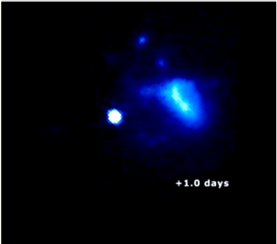Short-Hard Gamma-Ray Bursts
Gamma-ray bursts (GRBs) are the brightest electromagnetic sources in the Universe. Within seconds, these ultra-relativistic sources release more energy than our sun will over its entire life time. Two types of GRBs are observed: short-duration hard spectrum GRBs and long-duration soft spectrum GRBs. For many years, long GRBs were the focus of intense research while the lack of observational data limited the study of short-hard GRBs. In 2005, a breakthrough occurred following the first detections of short GRB afterglows, longer wavelength emission that follows the burst of gamma-rays. Similarly to long GRBs, afterglow detections led to the identification of short GRB host galaxies and measurement of their redshifts. These observations established that short GRBs are cosmological relativistic sources that, unlike long GRBs, do not originate from the collapse of massive stars, and therefore constitute a distinct physical phenomenon. One viable model for the origin of short GRBs is the coalescence of compact binary systems (double neutron stars or a neutron star and a black hole), in which case short GRBs are the electromagnetic counterparts of strong gravitational-wave sources.
Over the years I studied many various aspects of these fascinating events. My results, as well as a comprehensive review of this field, are presented in a review that I wrote several years ago. These days we are working on providing, for the first time, a statistical GRB classification method (Collapsar or non-Collapsar) based on the GRB duration alone.



The optical afterglow of short GRB 050709, from our paper on the first detection of a short GRB afterglow (Fox et al., 2005)

